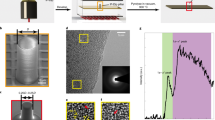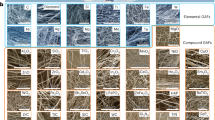Abstract
ATTEMPTS to derive a structural model for high-strength carbon fibres have led to studies of the development of microporosity during heat treatment. X-ray scattering and helium density measurements1 showed that carbonized rayon fibres have a fibrillar structure, with chains of graphite crystallites arranged parallel to the fibre axis and giving rise to needle-shaped micropores between the fibrils. The average diameter of the pores perpendicular to the fibre axis seems to vary from 6 to 20 Å for heat treatments in the range 900°–2,900° C.
This is a preview of subscription content, access via your institution
Access options
Subscribe to this journal
Receive 51 print issues and online access
$199.00 per year
only $3.90 per issue
Buy this article
- Purchase on Springer Link
- Instant access to full article PDF
Prices may be subject to local taxes which are calculated during checkout
Similar content being viewed by others
References
Perret, R., and Ruland, W., Paper SS-22, Ninth Carbon Conference, Boston, Mass., June 1969.
Rosenberg, A. J., J. Amer. Chem. Soc., 78, 2929 (1956).
Gregg, S. J., and Sing, K. S. W., Adsorption, Surface Area and Porosity, 86 (Academic Press, New York, 1967).
Goan, J. C., and Prosen, S. P., ASTM Symposium, San Francisco, June 1968.
Author information
Authors and Affiliations
Rights and permissions
About this article
Cite this article
MIMEAULT, V., MCKEE, D. Surface Areas of Carbon Fibres. Nature 224, 793–794 (1969). https://doi.org/10.1038/224793a0
Received:
Issue Date:
DOI: https://doi.org/10.1038/224793a0
This article is cited by
-
The crystallization and interfacial bond strength of nylon 6 at carbon and glass fibre surfaces
Journal of Materials Science (1975)
-
Pyrolytic surface treatment of graphite fibres
Journal of Materials Science (1974)
Comments
By submitting a comment you agree to abide by our Terms and Community Guidelines. If you find something abusive or that does not comply with our terms or guidelines please flag it as inappropriate.



